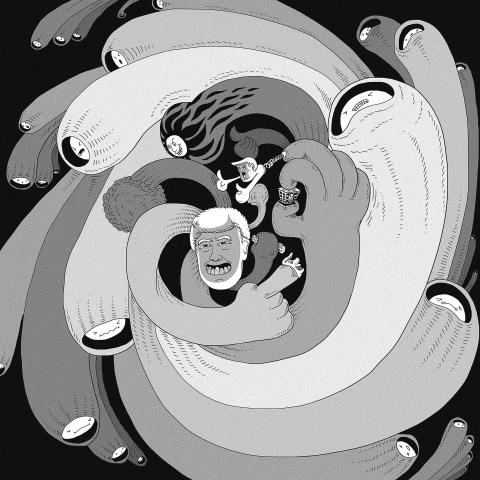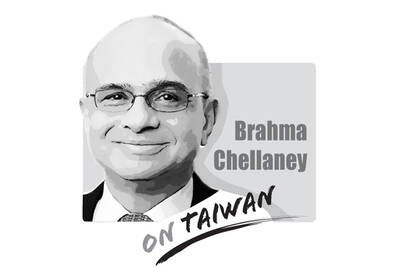Radical. That is probably the single adjective that best covers the disparate economic policies being pursued by Asia’s three largest economies.
Japanese Prime Minister Shinzo Abe’s administration has embarked on the 2.0 iteration of his program to break out of the country’s deflationary slump.
Chinese President Xi Jinping’s (習近平) administration is in the midst of a supertanker-like turn toward domestic consumption.

Illustration: Mountain People
In India, well… Indian Prime Minister Narendra Modi’s “Modinomics.”
These three countries hardly make for isolated laboratories for such experiments. Together they are home to 40 percent of the planet’s people and churn out 24 percent of the world’s GDP. Here is a roundup of how things are shaping up in these important economies.
INDIA
Fully 27 percent of the 1.28 billion people who inhabit the world’s fastest-growing major economy are younger than 15. Many of that 350 million cohort will be joining the country’s workforce in the next decade. That is surely not lost on Modi as he continues to hammer away at the inefficiencies that plague the Indian economy.
Since taking power in 2014, Modi has pursued a set of policies that aims not only to revive the economy, but also make it resilient to external shocks — and increasingly competitive with the developed world.
Reforms under Modi started off incrementally. In 2014 and 2015 he slowly massaged an economy that was showing signs of grinding to a halt.
A first priority was to attract foreign investors to set up manufacturing hubs, with Modi making almost 40 trips overseas during his first two years as prime minister.
The result: foreign direct investment commitments of more than US$75 billion in 2014 and 2015. Last year an additional US$33 billion of foreign investment flowed in.
Clearing the way for these businesses to be set up, Modi took a slew of steps to ease entry barriers. Among them were instituting a one-stop shop for clearances, hastening the permit process and relaxing government restrictions on a host of sectors.
Modi’s other major focus has been to manage government finances better and plug leaks in the system that derail efforts to get benefits to the poorest Indians, the 22 percent of the population who fall below the official poverty line. To wring corruption out of the system, the government linked the unique biometric-based identification issued to Indians — Aadhaar — with individual bank accounts and mobile phones. It uses this channel to transfer benefits directly, an application of technology that has been among Modi’s most successful projects.
Recent reforms have been even bolder. The demonetization of large-denomination rupee bills was meant to tackle tax avoidance and corruption and move India toward becoming a cashless society.
In addition, a national goods-and-services tax, which would subsume 14 separate central and state taxes into one uniform structure, aims to broaden the tax base and reduce compliance costs and tax-induced inefficiencies in the transportation of goods across the country.
Both initiatives have faced stiff opposition.
The results of Modinomics have been mixed. Economic growth increased to 7.3 percent in the third quarter of last year, up from 5.8 percent in the first quarter of 2014.
Inflation cooled to 3.4 percent, a drop that was aided in part by softer prices of many commodities that India imports.
The central bank has cut interest rates by 175 basis points since 2014, making credit cheaper for companies and bringing bond yields down to 6.4 percent.
CHINA
In the past two years the most populous country on Earth has transformed from being the world’s factory to a maturing economy. Xi’s government has focused on steadying China — especially on controlling excessive leverage and the spillover onto foreign exchange, rates and stocks.
Economic growth, which ran at a rate of more than 10 percent as recently as 2011, has leveled off. Last year, GDP increased 6.7 percent. China’s 13th five-year plan, which covers last year through 2020, projected a base GDP growth rate of 6.5 percent.
Meanwhile, interest rate policies have been cautious. While some market observers expected China to aggressively lower rates to kick-start the economy, the country’s seven-day repo fixing ended the year higher — at 3.24 percent. The reason for applying the brakes: China wants to rein in leverage and asset inflation.
The country’s equity market underperformed the world last year. The onshore benchmark CSI 300 Index lost 9.3 percent in total return. The offshore MSCI China Index gained 1.2 percent. Both lagged the MSCI World Index, which climbed 8.2 percent.
For global investors, the main concerns are slowing growth and yuan devaluation risk. Although China equity valuations do not look particularly lofty, investors are underweighting China as they see downside earnings risk.
Faced with limited investment opportunities, dismal returns and the prospect of a weaker yuan, onshore investors are looking overseas for opportunities. Chinese corporations are ramping up cross-border mergers and acquisitions. Individual investors are snapping up overseas assets, including insurance products and real estate.
Beijing wants to promote the internationalization of China’s financial markets, but remains concerned about the potential impact on stability. The high volatility seen in the onshore equity market in 2014 and 2015 has made regulators more cautious.
However, the general trend is toward more opening up of financial markets. A trading link between the Shenzhen and Hong Kong markets opened in November last year, joining the Shanghai-Hong Kong Stock Connect.
China’s agenda this year is not exactly simple: It has to balance slower growth, interest rates, foreign exchange rates, global fund flows and its pace of opening up markets. And that is before adding in a couple of wild cards that are out there. (Cough) trade wars (cough), anybody?
Interesting times.
JAPAN
Japanese Prime Minister Abe unveiled “Abenomics 2.0” in September 2015. This iteration of his four-year-old reform agenda aims to break the vicious deflationary cycle that has afflicted the Japanese economy for two decades.
To do that, it seeks to foster confidence and a sense of security, putting the country back on track to a nominal GDP of ¥600 trillion (US$5.29 trillion) by 2020. That would require growth of 3 percent per year. In the third quarter, Japan’s economy grew at an annualized pace of 1.3 percent.
In addition to boosting short-term economic activity, Abenomics seeks to finance long-term goals such as fixing pension systems and improving social security. Part of that involves raising taxes to trim Japan’s mountain of debt.
Consumption taxes and individual income taxes account for the largest portions of the nation’s revenue, each representing almost 30 percent. Corporate taxes account for about 20 percent — relatively high compared with peer countries. Japan is easing corporate taxes while keeping income taxes untouched. Thus, without a substantial increase in economic activity, a consumption tax hike would be crucial to make up lost revenue.
However, the government last year deferred raising the consumption tax until 2019, taking into account the fragile economy and uncertain global environment in the first half of last year.
A challenge for Abe now is how to maintain the positive momentum until the introduction of the new consumption tax rate. In next month’s party convention, the Liberal Democratic Party will likely approve the extension of its presidency tenure to nine years from six, enabling Abe to remain as leader until September 2021.
Even given that time frame, Abe’s task might be to provide “floors” to the economy, rather than pursuing the remarkable economic growth that he advocates — at least until the consumption tax rate hike.
The Bank of Japan (BOJ) is likely to continue to pay the costs of such floors. The central bank already holds almost 40 percent of Japanese government bonds. Through its buying of exchange-traded funds, the BOJ will become the largest shareholder of 25 percent of the companies in the Nikkei 225 Index by the end of this year, according to a Bloomberg estimate.
The biggest risk for the government and the central bank is yen appreciation. The “Trump shock” weakened the yen by almost 10 percent from the time of the US election through the end of last year. That pushed Japan’s stock indexes into positive territory for the year — and helped Abenomics.
Abe may need more such luck.

Donald Trump’s return to the White House has offered Taiwan a paradoxical mix of reassurance and risk. Trump’s visceral hostility toward China could reinforce deterrence in the Taiwan Strait. Yet his disdain for alliances and penchant for transactional bargaining threaten to erode what Taiwan needs most: a reliable US commitment. Taiwan’s security depends less on US power than on US reliability, but Trump is undermining the latter. Deterrence without credibility is a hollow shield. Trump’s China policy in his second term has oscillated wildly between confrontation and conciliation. One day, he threatens Beijing with “massive” tariffs and calls China America’s “greatest geopolitical
Chinese Nationalist Party (KMT) Chairwoman Cheng Li-wun (鄭麗文) made the astonishing assertion during an interview with Germany’s Deutsche Welle, published on Friday last week, that Russian President Vladimir Putin is not a dictator. She also essentially absolved Putin of blame for initiating the war in Ukraine. Commentators have since listed the reasons that Cheng’s assertion was not only absurd, but bordered on dangerous. Her claim is certainly absurd to the extent that there is no need to discuss the substance of it: It would be far more useful to assess what drove her to make the point and stick so
The central bank has launched a redesign of the New Taiwan dollar banknotes, prompting questions from Chinese Nationalist Party (KMT) legislators — “Are we not promoting digital payments? Why spend NT$5 billion on a redesign?” Many assume that cash will disappear in the digital age, but they forget that it represents the ultimate trust in the system. Banknotes do not become obsolete, they do not crash, they cannot be frozen and they leave no record of transactions. They remain the cleanest means of exchange in a free society. In a fully digitized world, every purchase, donation and action leaves behind data.
Yesterday, the Chinese Nationalist Party (KMT), once the dominant political party in Taiwan and the historic bearer of Chinese republicanism, officially crowned Cheng Li-wun (鄭麗文) as its chairwoman. A former advocate for Taiwanese independence turned Beijing-leaning firebrand, Cheng represents the KMT’s latest metamorphosis — not toward modernity, moderation or vision, but toward denial, distortion and decline. In an interview with Deutsche Welle that has now gone viral, Cheng declared with an unsettling confidence that Russian President Vladimir Putin is “not a dictator,” but rather a “democratically elected leader.” She went on to lecture the German journalist that Russia had been “democratized